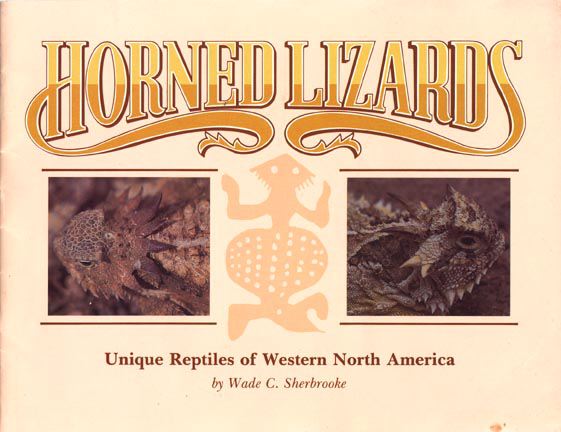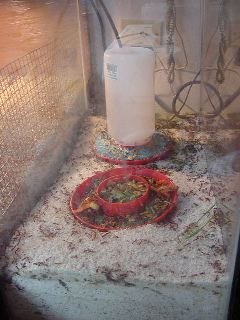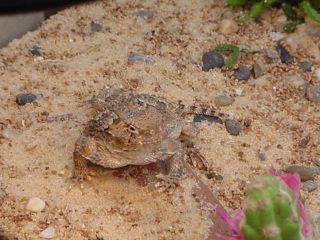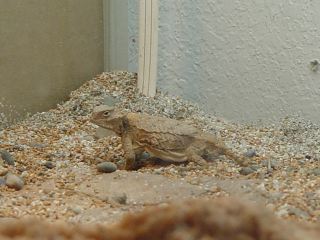
I have been keeping Horned lizards for several years.
In the last two years I have started to get serious about trying to
breed these fascinating lizards.
I succeded this past year.
I grew up in Nevada and found that keeping the Desert Horned
lizards (Phrynosoma platyrhinos ssp.) was much easier
when I lived in the desert as I could collect ants, specimens
and habitat decorations.
Living in Alaska poses a special problem for keeping these lizards,
There are No harvester ants. These is no desert sand, or other desert
items to aid in setting up a naturalistic vivarium.
Everything is ordered online and the reliance on the mail, weather
and other unseen factors all play into the decision to attempt to
keep and breed Horned Lizards.
None who is NOT fully prepared for success
and failure should attempt to keep them anywhere.
Keeping Horned lizards happy requires feeding the correct food items.
Red Ants are a necessity. Red Harvester ants constitute up to 90%
of the diet of the horned Lizard.
I order ants from Life Studies Company.
Life Studies Red Ants, online.
Life studies provides a lot of information on keeping “ants”.
Life Studies is located; 490 S. 400 W.Hurricane, UT 84737
Toll Free Phone #:1-877-864-2207./ Fax#:1-435-635-9005
Email Address: mailto:life@infowest.com
Life studies has reduced shipping in winter months.
So eMail them Prior to ordering!
Horned lizards may also eat small crickets, mealworms and beetles,
wax worms and they love moths!
For anyone wishing to keep and PROPERLY feed Horned Lizards, Red Harvester ants are the MUST..
Without them they will die.
So if you want to keep horned lizards and you do not live somewhere
out west where the Harvester ants are found, you must order them.
So plan to spend at least $30.00 per month /about 3,000 ants per eight
to 10
horned lizards. Otherwise you will not successfully keep horned lizards.
I realize that this is a blunt statement, but it is true.
Despite what people say, they will not survive on crickets that are nuked with supplements.
Ants contain Formic acid and trace elements that are absolutely required.
Horned lizards are very active between 5:30am until around noon,
when the sun is at it’s nearly hottest location.
Horned lizards, then retreat into shaded retreats that they have
escavated or found and remain hidden until about 4:00pm when
they are again active until slightly after dark.
Horned lizards actively feed on ants from about two hours after
sun rise, when they reach emergence temperatures and eat again in the afternoon.
Horned lizards, commonly eat many types of insects and are known as ambush predators.
They eagerly consume red ants which they eat with vigor.
Watching a horned lizard stand near the mound of ants and eat is quite a interesting scene.
After eating large gulps of red ants, that are scooped up with the tongue
they often seem to pause and shake slightly as if they were eating jallipino peppers.
Internal parasites are common in the digestive tracts of Phrynosoma.
What exact the role of these nematodes play in digestion,
or what problems that they cause are unclear.
Most experts of Phrynosoma seem to agree that the nematodes
in Horned lizards cause little harm and thus may
actually aid in some manner in the digestion or conversion of formic acids.
So captive horned lizards need not be de-wormed with panacur
or another herpetoculturial method, unless serious and obvious
problems occur from them in captive specimens.
There are 14 species of Phrynosoma and several subspecies also.
Some horned lizards are oviparous (egg layers) and some are
live-bearers (viviparous). Generally it seems that horned lizards
that are native to higher elevations are often times live-bearing.
Captive Care:
Horned lizards require daytime temperatures between 85 and 95f.
Prove a “hot” spot that has a 100 or more watt spot lamp.
Which keeps a spot at about 115f.
The horned lizards will move in and out of this “hot” spot.
when adjusting body temperature.
Lighting indoors must be both U.V.a/b and be no
more than 12" above the lizards.
A timer should be used with 12-14 hours "on".
Hibernation is also a must with horned lizards.
Feeding is as stated above.
Water is a touchy subject in herpetoculturial circles.
Many hobbyists assert that leaving a water bowl in with horned
lizards can cause humidity levels to rise to harmful levels.
I do not agree, and always have a small shallow rock type dish with
water available. If you keep horned lizards in cramped, stuffy stale air
enclosures, then YES, the humidity will rise, but other factors will kill
your horned lizards long before the humidity does!
Make sure that you have good air circulation.
I personally have seen my specimens drink by lapping at the water
and I have seen them soak.
Substrate should be sand or fine litter.
Avoid the Walnut shell litter as it can cause impaction problems.
A few rocks and or cave type shelters should be provided.
although, horned lizards may not care, a few succulents or hardy
desert bushes make the vivarium much more natural.
A natural setting will make horned lizards feel more at home.
There are many articles and a few books available to the Phrynosoma
hobbyist.
Horny Toads as Pets; By John Seginski.
is a fine basic guide to keeping Horned lizards.
This small guide is available from:
TJE Publications, P.O. Box 50141, Reno, Nevada 89513.
Horned Lizards; By Jane Manaster
Is another book to offer information on them, however it is more from the conservation and history standpoint.
It is available from online sellers such as Amazon or Barns and Nobel.
One of my Favorite H.L. books is:
Horned Lizards; Unique Reptiles of the Western North America.
By Wade C. Sherbrooke.
This guide not only discusses aspects to identifying the species but
includes blurbs on breeding and parasites.
For more information on Horned Lizards on the web please check
out this link to the conservation page at:Horned Lizard conservation page
Gallery of Horned lizard and Related photographs:
ANTS.

Harvester ants, the REQUIRED food.

Waxworms.

Desert Horned Lizards. {Phrynosoma platyrhinos}.
A breeding trio of Desert Horned lizards.






August 01' Baby Desert HL Photos:

Round tailed Horned Lizards {Phrynosoma modestum}

Roundtail Horned Lizards.
What a beauty!

A female roundtail Horned lizard.


herpetoculture Index
Horned lizard Forum